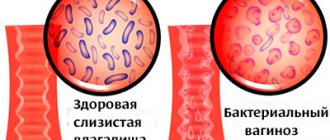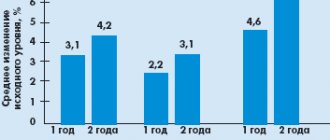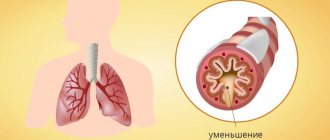Lipid metabolism disorders (dyslipidemia) affect the processes of absorption, transformation and metabolism of fats in the body. In addition to their energy function, fats are an important component of cell membranes, participate in the synthesis of hormones, transmit nerve impulses, and perform a host of other vital tasks. Therefore, a violation of lipid metabolism significantly affects the condition of the entire organism as a whole and can lead to the development of severe consequences.
Causes of dyslipidemia
- Nutritional – eating large amounts of animal and vegetable fats. The norm is set individually for each person, the average is from 0.8 to 1 g. fat per kilogram of body weight per day.
- Congenital disorders of lipid metabolism. They arise as a result of mutations in genes that are responsible for the processes of synthesis, breakdown, and transportation of fats. These mutations are passed on from generation to generation, so the disease can occur in young children for no apparent reason. Examples of genetic disorders of lipid metabolism are Gaucher disease, Tay-Sachs disease, and Niemann-Pick disease.
- Secondary disorders of lipid metabolism. Caused by other diseases that can affect the gastrointestinal tract, endocrine and enzyme systems, various internal organs (liver, kidneys).
Among the provoking factors that increase the risk of developing lipid metabolism disorders are bad habits (smoking, alcohol abuse), a sedentary lifestyle, excess weight, chronic stress, and taking hormonal medications.
Symptoms, causes, diagnosis and treatment of lipid metabolism disorders
The increase in the content of fat-like substances - lipids - in the blood is influenced by three main factors: excess intake of fat into the body from food, impaired excretion and increased synthesis in the body.
Depending on the mechanism of development of the disease, the causes of dyslipidemia are different.
Pathology can be:
- primary (due to hereditary factors);
- secondary (as a result of complications of any diseases);
- nutritional (if the human diet is oversaturated with animal fats).
An anomaly is often recognized after the fact, when problems with the cardiovascular system arise, since lipid metabolism disorders are most often asymptomatic. But in some patients, due to high levels of LDL, clouding of the cornea occurs, and xanthomas appear on the elbows and knees, and on the soles. With very high triglyceride levels (exceeding 11.3 mmol/l), pancreatitis develops and xanthomatous rashes are observed on the body.
Diet
Diet for vascular atherosclerosis
- Efficacy: therapeutic effect after 2 months
- Dates: no data
- Cost of products: 1700-1800 rubles. in Week
DASH Diet
- Efficacy: therapeutic effect after 21 days
- Timing: constantly
- Cost of products: 1700-1800 rubles. in Week
Patients are prescribed a diet low in fat, simple carbohydrates and an increased intake of dietary fiber up to 40 g. In the diet of patients, the amount of unsweetened fruits and vegetables with a low starch content, vegetable oils, beans, nuts, chickpeas, soybeans, fish, whole grain products, low-fat yoghurts At the same time, red meat, processed meats and salt are reduced. The traditional diet for hypercholesterolemia is the DASH and Mediterranean . These diets are effective in reducing cardiovascular disease factors. The Mediterranean diet includes olive oil or nuts.
When following this diet, there is a 30% decrease in cardiovascular diseases. Canola, flax, corn, olive and soybean oils reduce LDL cholesterol levels.
The main points of nutrition for patients are:
- Avoiding consumption of trans fats.
- Limiting saturated fats (only 7% of them are allowed in the diet).
- Limiting the intake of cholesterol from food (less than 300 mg/day - one chicken egg covers the need for cholesterol).
- Reducing the amount of carbohydrates, it is advisable to completely eliminate simple carbohydrates from the diet. Carbohydrates have a neutral effect on low-density lipoproteins, but excessive consumption of highly refined carbohydrates indirectly (via insulin) adversely affects triglycerides and low-density lipoproteins.
- Reduce consumption of foods with cholesterol.
- Increase in dietary fiber, which has a hypolipidemic effect. Soluble dietary fiber, which is found in fruits, vegetables, legumes, and whole grain cereals, is effective in this regard. Coarse plant fiber (cabbage, lettuce, carrots, grapefruits, apples, pears) partially adsorbs cholesterol and also prevents the absorption of fats.
- Eating foods rich in phytosterols . Regular consumption of such foods reduces cholesterol levels by 10%. Phytosterols are found in corn, soybeans, lentils, peas, vegetable oils, beans, whole grains, pumpkin seeds, sesame seeds, pistachios, and walnuts.
- Consuming omega-3 PUFAs.
Classification of lipid metabolism disorders
Today, the Fredrickson classification of dyslipidemias is considered the main one:
- The cause of type 1 dyslipidemia is enzyme deficiency. Violations of this type are quite rare.
- Dyslipidemia 2a occurs due to mutations in genes and is one of the most common types of lipid metabolism disorders.
- Dyslipidemia 2b also occurs quite often and can be either hereditary or combined (the cause may be previous diseases and a diet oversaturated with animal fats).
- Type 3 lipid metabolism disorders are characterized by an increase in triglycerides and LDL in the blood.
- Type 4 hyperlipidemia, characterized by an increase in VLDL, is of endogenous origin.
- Dyslipidemia type 5 occurs when the level of cholinomicrons in the blood increases and also refers to hereditary disorders.
Diagnostic measures
Diagnostic procedures include a consultation with a physician, physical examination, medical history, and blood chemistry tests.
During a physical examination, the doctor notes the possible presence of xanthelasma, xanthomas, and lipoid arch of the cornea. Patients often experience high blood pressure. Auscultation (listening) and percussion (tapping) are not informative, since they are not accompanied by changes in dyslipidemia.
To identify inflammation and concomitant diseases, a laboratory test of blood and urine is prescribed. Genetic analysis identifies genes that carry hereditary information and are responsible for the development of type 2 dyslipidemia.
A biochemical blood test allows you to determine the level of total blood protein and sugar, uric acid and creatinine to detect concomitant organ damage. Immunological analysis determines the content of antibodies to cytomegalovirus and chlamydia, as well as the level of C-reactive protein.
But the main method for diagnosing dyslipidemia is a lipidogram - a blood test for fat-like substances, lipids. When measuring the lipid spectrum
The levels of triglycerides, total cholesterol, LDL and HDL are determined.
The studies are carried out on an empty stomach, in NEARMEDIC's own laboratory.
Treatment of dyslipidemia is prescribed after a complete diagnosis, accurate diagnosis and determination of the cause of the pathology.
Procedures and operations
Patients in whom drug treatment is ineffective undergo extracorporeal removal of low-density lipids. Most often, this method is used for familial hypercholesterolemia (homozygous and heterozygous). These are hardware methods based on plasma filtration and plasma sorption. Other types of techniques are also used: immunosorption, heparin precipitation, plasmapheresis. During the procedure, lipoproteins are precipitated and removed by membrane filtration, and the plasma is returned to the patient. There are diseases for which plasmapheresis is used as the first line of treatment, while for others it is used as the second line or in combination with other treatments.
Treatment of dyslipidemia
Treatment of dyslipidemia is complex and includes:
- Drug therapy - fibrates, vitamins, statins and other drugs that correct lipid metabolism disorders;
- Non-drug treatment - weight normalization through fractional meals, dosed physical activity, limiting alcohol and smoking, and stressful situations.
- Diet therapy - foods rich in dietary fiber and vitamins are recommended (vegetables, cereals, fruits, beans, low-fat lactic acid products); fatty and fried meats are not allowed.
If lipid imbalance is a secondary pathology resulting from exposure to negative factors or any disease, NEARMEDIC cardiologists prescribe therapy aimed at timely detection and treatment of the underlying disease.
Dyslipidemia develops over years and requires equally long-term treatment. You can prevent further disturbances in lipid metabolism by strictly following the recommendations of doctors: move more, watch your weight, quit bad habits.
Contact your doctors on time!
In the early stages, stopping the pathological process is much easier. Timely therapy, elimination of risk factors and disciplined implementation of doctors’ recommendations significantly prolong and improve the lives of patients
Contact our clinics, do not delay your visit to the doctor. You will be consulted by experienced doctors, and you will undergo an expert examination using high-tech diagnostic equipment. Based on the results obtained, the cardiologist will prescribe competent treatment for dyslipidemia and recommend preventive measures.
To make an appointment with a cardiologist, call or fill out a request on the website.
Dyslipidemias are one of the most common metabolic disorders. The connection between dyslipidemia and dermatoses, for example, the connection between psoriasis and dyslipidemia, was discovered relatively recently. Many dermatoses may have a systemic inflammatory component, which explains this association. Chronic inflammatory dermatoses may have other metabolic imbalances that may contribute to dyslipidemia. The presence of such abnormal metabolism may justify routine screening of these diseases for the presence of dyslipidemia and other metabolic disorders, for early treatment of such comorbidities and improvement of the patient's quality of life. Some of the drugs used by dermatologists, such as retinoids, are also likely to cause dyslipidemia. Therefore, it is critical that dermatologists gain scientific knowledge of the underlying mechanisms involved in dyslipidemia and understand when to adjust treatment. This review attempts to list the dermatological diseases associated with dyslipidemia; to simplify understanding of the underlying mechanisms; and give a brief overview of treatment adjustments.
Introduction
Dyslipidemia is a disorder of lipoprotein metabolism, including excess lipoproteins and their deficiency. These disorders may manifest as increased serum concentrations of total cholesterol, low-density lipoprotein (LDL), triglyceride (TG) concentrations, and decreased concentrations of high-density lipoprotein (HDL). [1] Blood lipid changes are a growing health problem worldwide. Studies conducted in India have shown an increase in the prevalence of dyslipidemia, even among the young adult population. [2] Dyslipidemia plays a critical role in the development of cardiovascular diseases, which has become the leading cause of death in most developed and developing countries. [3] It is now known that dermatological diseases such as psoriasis are associated with dyslipidemia. [4] Some dermatological treatments are known to predispose to lipid disorders. A clear understanding of the pathogenesis of such events allows us to provide appropriate advice to patients.
Pathogenesis of dyslipidemia
Dyslipidemia may result from overproduction of lipoproteins or lack of clearance of lipoproteins, may be associated with other defects in apolipoproteins, or there may be a deficiency of metabolic enzymes. The pathways and means of lipid metabolism in the human body reflect the interaction of genetics, complex biochemical processes influenced by diseases, drugs and/or environmental factors. Phenotyping these dyslipidemias is challenging and has been ongoing for many decades. [5]
Primary dyslipidemia (eg, familial hypercholesterolemia) typically refers to a genetic defect in lipid metabolism that causes abnormal lipid levels. Secondary dyslipidemia can be due to various causes, such as environmental factors (diet rich in saturated fat or sedentary lifestyle), diseases (type 2 diabetes, hypothyroidism, jaundice, etc.), and medications (thiazide diuretics, progestins, anabolic steroids, etc.). Secondary dyslipidemias can be corrected or corrected by treating the underlying disease. Dyslipidemia may result from a combination of genetic and secondary causes. [5]
Dyslipidemia and skin
Many dermatological diseases are known to be associated with dyslipidemia. Most of them are chronic inflammatory diseases and the secretion of proinflammatory cytokines may be the basis of their pathogenesis. Studies have shown an increased risk of dyslipidemia in skin diseases such as psoriasis, lichen planus, pemphigus, granuloma annulare, histiocytosis and connective tissue diseases (such as lupus erythematosus). Table 1 shows lipid disorders and associated diseases.
Table 1. Dermatological diseases associated with dyslipidemia
| Disease | Deviations in the lipid spectrum |
| Psoriasis | Low HDL, elevated total cholesterol, TG and LDL |
| Lichen planus | High LDL, total cholesterol, increased ratio of total cholesterol to HDL and LDL to HDL |
| Pemphigus | High levels of total cholesterol and TG |
| Granuloma annulare | Low HDL, elevated total cholesterol, TG and LDL |
| Discoid lupus erythematosus | Low levels of HDL, HDL2, HDL3 subratios |
| Histiocytosis | hypercholesterolemia |
Psoriasis is a chronic inflammatory, immune-mediated skin disease affecting 2-3% of the population, characterized by hyperproliferation and altered differentiation of keratinocytes. [6] The exact etiology of psoriasis is unknown; one theory suggests that the disease has an autoimmune basis with a strong genetic component. Several cardiovascular risk factors are also associated with psoriasis. [4,7] Some studies, although with relatively small patient groups, have shown an atherogenic dyslipidemic profile consisting of increased levels of total cholesterol, triglycerides, LDL, oxidatively modified lipids, and decreased HDL levels. [8,9,10] Recent studies have also shown that the prevalence of metabolic syndrome is significantly higher in patients with psoriasis compared with controls after the age of 40 years and patients with psoriasis have an increased risk for individual components of the metabolic syndrome. [11,12,13] Components of metabolic syndrome include hyperglycemia, obesity, hypertension, and dyslipidemia.
Lichen planus is also a common chronic inflammatory skin disease. There are reports of an association of lichen planus with dyslipidemia [14,15,16]. Chronic inflammation in patients with lichen planus may explain the association with dyslipidemia. Studies have reported that patients with lichen planus have significantly higher levels of various lipids compared to controls [Table 1] [15]. Screening lipid levels in men and women with lichen planus may be useful in identifying those at increased risk so that preventive treatment can be initiated to prevent the development of cardiovascular disease. [16]
Lichen planus. is a common chronic inflammatory disease of the skin and mucous membranes, which is characterized by a wide range of clinical manifestations. Its classic clinical presentation is associated with the appearance of purple, polygonal papules and plaques.
Pemphigus vulgaris is a potentially fatal autoimmune blistering disease affecting the mucous membranes and skin, often requiring long-term, immunosuppressive treatment. [17] The association between pemphigus and dyslipidemia was established in a case-control study conducted at the medical base of a large health care organization in Israel. They observed an association between pemphigus and dyslipidemia by examining serum lipid profiles. Serum total cholesterol and triglyceride levels were elevated in patients with pemphigus compared with controls. Lipid levels were even higher when factors such as obesity, diabetes and hypertension were present; unrelated to corticosteroid use. Neither LDL nor HDL was associated with pemphigus. [18]
Hypercholesterolemia, hypertriglyceridemia, elevated LDL cholesterol, and low HDL cholesterol have been demonstrated in patients with granuloma annulare. More common in generalized forms than in localized ones, the morphology of ring-shaped lesions has been found to be associated with hypercholesterolemia and dyslipidemia. [19]
Patients with discoid lupus erythematosus are known to have lipid abnormalities that aggravate the disease. In addition, there is an increased risk of atherosclerosis due to noted disease-associated dyslipidemia. [20]
Non-Langerhans cell histiocytosis may also be associated with dyslipidemia. Hyperlipidemia can also be one of the manifestations of cutaneous necrobiotic xanthogranuloma. [21,22] Blue histiocytosis is also associated with hyperlipidemia. [23]
Mechanisms involved between skin diseases and dyslipidemia
Numerous mechanisms have been proposed to explain the association between inflammation and dyslipidemia: modulation of lipoprotein lipase (LPL) enzymatic activity by anti-LPL antibodies and reduction of LPL activity due to various proinflammatory cytokines such as tumor necrosis factor TNF-α, IL-1, IL-1 -6, interferon-γ and monocyte chemoattractant protein-1. In addition, atherogenic autoantibody complexes to oxidized LDL and oxidized anticardiolipins are generated in response to oxidative anti-inflammatory effects, which increase the accumulation of LDL in endothelial walls. [24]
Psoriasis is characterized by increased immune activity of Th1 and Th17 cells. Cytokines such as TNF-α, IL-6, IL-17, IL-20, leptin, and vascular endothelial growth factor play a central role in both psoriasis and metabolic syndrome. [25] On the other hand, metabolic syndrome itself may predispose an individual to the development of psoriasis. [26,7] Lichen planus is associated with immunological abnormalities of delayed-type hypersensitivity, in which activated T cells and other inflammatory cells such as dendritic cells are the key components. [27,28] These processes may explain the association between lichen planus and dyslipidemia, and other components of the metabolic syndrome.
Dermatological drugs causing dyslipidemia
Several medications used to treat dermatological diseases can trigger or worsen dyslipidemia. [Table 2] Systemic retinoids and immunosuppressants such as cyclosporine used to treat skin diseases such as psoriasis may worsen dyslipidemia.
Table 2. Effect of drugs used in dermatology on lipid metabolism
| A drug | Effect on lipid profile |
| Systemic retinoids | Elevated levels of TG, LDL and low levels of HDL |
| Cyclosporine | Affect many aspects of lipids and their metabolism |
| Tacrolimus | Increase in TG and decrease in lipoprotein lipase |
| Steroids | Increase in HDL, TG and total cholesterol |
| Stanazol | Increase in LDL and decrease in HDL |
| Antiretroviral drugs | Increase in HDL, TG and total cholesterol |
Hypertriglyceridemia is a metabolic complication of systemic retinoid therapy that may occur in up to 17% of cases. [29] The Apo C-III gene may be a target for retinoids acting through the retinoid X receptor. Increased expression of Apo C-III may contribute to the hypertriglyceridemia and atherogenic lipoprotein profile observed after retinoid therapy. [29] Many of the existing immunosuppressive drugs, such as cyclosporine, tacrolimus and sirolimus, are associated with an increase in one or more risk factors influencing the development of atherosclerosis [30]. Cyclosporine A, an immunosuppressant that is widely used in transplant patients, is also used in dermatology, for example for psoriasis. Long-term treatment with cyclosporine is associated with hyperlipidemia and an increased risk of atherosclerosis. Importantly, hyperlipidemia normalizes after discontinuation of cyclosporine, thereby confirming its role [31]. One possible cause for hyperlipidemia is inhibition of the synthesis of bile acids from cholesterol and the transport of cholesterol into the intestine. Another reason is that cyclosporine binds to the LDL receptor, which increases LDL levels; There is a noticeable decrease in post-heparin lipolytic activity, with an increase in hepatic lipase and a decrease in LPL activity, which leads to impaired clearance of VLDL and LDL. [32,33] Binding of cyclosporine to the LDL receptor by cyclosporine-containing LDL cholesterol particles has also been proposed as a mechanism for the cellular uptake of cyclosporine. [34] Cyclosporine may have a pro-oxidant effect on LDL levels, which may increase the risk of coronary heart disease, including the accelerated development of atherosclerosis that has been observed in recipients. [35]
Tacrolimus significantly increases plasma triglyceride concentrations and decreases LPL concentrations and activity in renal transplant patients, regardless of any lipid-lowering treatment the patients received. Decreased LPL activity, partly due to decreased plasma concentrations following tacrolimus administration, may explain hypertriglyceridemia. [36] Currently, tacrolimus is used by dermatologists only as a topical agent. Its absorption from the skin is minimal; therefore, may not be an important factor in dyslipidemia.
However, with respect to other immunosuppressants such as mycophenolic acid or azathioprine used in dermatology, there is no convincing data to suggest that they cause clinically significant increases in any lipid fractions.
Steroids are also associated with dyslipidemia. Corticosteroids raise all lipoprotein levels.[37] This is due in part to the relative deficiency of adrenocorticotropic hormone (ACTH) caused by long-term steroid use. Corticosteroids are the mainstay of treatment for pemphigus and many other autoimmune and inflammatory diseases. The main explanation for the association between dyslipidemia and pemphigus is long-term treatment with corticosteroids.[18] Corticosteroid-induced dyslipidemia is likely the result of weight gain, which leads to insulin resistance, increased hepatic LDL secretion, and increased total cholesterol and triglyceride levels. [38,39,40] Studies have shown that anabolic androgenic steroids like stanazol can lead to dyslipidemia, leading to an increase in LDL and a decrease in HDL. A noticeable decrease in HDL and HDL2 cholesterol occurs due to an increase in lipase in the liver. [41,42]
Antiretroviral therapy (ART) may also contribute to dyslipidemia. However, dyslipidemia does not develop in everyone who takes these drugs, suggesting that host factors play a role. Protease inhibitors lead to atherogenic changes in their lipoprotein profile, consisting of increased TG, LDL and total cholesterol and increase the risk of coronary artery disease. [43,44] Nonnucleoside reverse transcriptase inhibitors show, in general, the best lipid profile of all ART drugs because they are associated with an increase in HDL. [44]
Biologics used in the treatment of skin diseases are also associated with dyslipidemia. TNF inhibitors used to treat psoriasis may have varying effects on lipids. Long-term infliximab therapy may be proatherogenic, whereas etanercept and adalimumab may have beneficial effects on lipids. [45]
Dermatological manifestations of dyslipidemia
Xanthomas are dermatological manifestations associated with lipid disorders. They arise as a result of the absorption of lipids by macrophages. Clinically, xanthomas are classified as tendinous, tuberous, eruptive and flat. They may be associated with familial or acquired hyperlipidemia, lipoproliferation of malignancies, or may not have an underlying disease. [46] Xanthomas can be found in ligaments and tendons, although they can also be found in the periosteum and fascia. [47] Tendon xanthomas are located along the tendons of the arms and the Achilles tendon. Tuberous xanthomas appear as yellow nodules; often associated with hypertriglyceridemia and sometimes hypercholesterolemia. [48] Flat xanthomas are patchy or slightly raised features that can occur anywhere and can involve large areas of the body. Common flat xanthomas can cover large areas of the body, including the face and neck. Xanthelasma is a flat xanthoma in the form of a yellowish plaque located on the skin of the eyelids or periorbital area. [49] The development of a xanthoma on the palmar crease is usually called striatum palmare xanthoma and is an important sign of type III hyperlipoproteinemia. [50] Eruptive xanthomas are orange-yellow papules in hyperglyceridemia and uncontrolled diabetes. [51]
Prevention of dyslipidemia
The basic principles of correction of dyslipidemia include: treatment of secondary or associated causes such as diabetes, discontinuation of offending medications (in this case, consider an alternative route of treatment or reduce the dosage, if possible). Regardless of the underlying dermatologic disease, smoking cessation and reduction of other modifiable risk factors are important aspects of coronary artery disease prevention. [1]
With steroid therapy given in the morning at a minimal dose, lifestyle changes including exercise, weight control, [52] avoidance of fatty foods, and treatment of diabetes mellitus, if present, can all help, complementing or even supplanting drug therapy. Studies related to cyclosporine dyslipidemia are probably best derived from experience and evidence in renal transplant patients. There has been conflicting data on whether dyslipidemia is dose dependent on cyclosporine and one large study did not show a relationship. [53] In addition, dermatological conditions such as psoriasis, for which cyclosporine is used, have an independent association with metabolic syndrome. Therefore, it is prudent to be more proactive in the treatment of these patients, including pharmacotherapy for dyslipidemia and dysglycemia in these patients.
Hypertriglyceridemia remains the most common lipid disorder among patients with human immunodeficiency virus (HIV). Fenofibrate is the fibrate of choice for HIV-infected patients who have hypertriglyceridemia due to the lack of serious drug interactions and evidence of better cardiovascular effects. Dual therapy with the addition of statins may be necessary if LDL is elevated. Due to the multifactorial nature of HIV infection and associated dyslipidemia, changes in treatment may not achieve the expected results. [54]
Eruptive xanthomas caused by hypertriglyceridemia respond well to lifestyle changes and lowering lipid levels with fibrates. It has been noted that eruptive xanthomas usually disappear within a few weeks after systemic treatment, tuberous xanthomas after a few months, but the disappearance of tendon xanthomas may take years or they may persist indefinitely. [55]
Lifestyle changes
Lifestyle approaches including dietary changes are the main approach to treating children and young people. Physical activity offers many benefits such as weight loss, decreased insulin resistance, decreased triglyceride levels, increased HDL, and improved cardiovascular function. Dietary approaches include: consuming low-fat and low-fat dairy products, avoiding trans fats and animal fats, using vegetable fats, limiting egg yolk intake, and avoiding meats and foods high in saturated fat (eg, liver) [56] For elevated triglycerides , you need to avoid sugar, sweetened drinks, juices and refined carbohydrates.
Drug treatment
Statins, drugs that reduce the risk of cardiovascular disease and cardiovascular mortality, have significantly replaced bile acid resin drugs due to their side effects. Statins primarily lower LDL levels. Rosuvastatin is a more powerful drug than atorvastatin or pravastatin and is also more effective at lowering triglyceride levels. Statins reduce endogenous cholesterol production by inhibiting the key enzyme 3-hydroxy-3-methylglutaryl coenzyme. They are generally well tolerated, but you need to be aware of possible adverse reactions such as liver damage, muscle cramps and rhabdomyolysis. They also cause skin side effects such as: autoimmune reactions, dry skin, severe reactions such as drug hypersensitivity syndrome (DRESS) and allergic reactions. [57] Statins should be avoided during actual or possible pregnancy, as they have a teratogenic effect. Ezetimibe may be a useful adjunct in severe cases. Fibrates are a lifeline for the treatment of hypertriglyceridemia and may be chosen over niacin, which is poorly tolerated by many patients. Omega-3 fatty acids may be used additionally or alternatively when fibrates cannot be used, for example during pregnancy.
The evidence base for pharmacological intervention for dyslipidemia in childhood is limited. Lipid-lowering therapy is intended for high-risk groups, that is, children at least 10 years of age who have an LDL level of 190 mg/dL or higher or 160 mg/dL or higher and who have other risk factors such as diabetes mellitus, etc. d.
Drugs that affect chylomicron production, such as orlistat, are also effective for patients with hypertriglyceridemia. [58]
Conclusion
Dyslipidemia in dermatoses appears to be a more common problem than expected. Many dermatoses are discussed in this article, but more diseases may be added to this list in the future. Their treatment may include lifestyle modifications and pharmacotherapy. Dietary counseling can help control underlying disease and may provide an opportunity to reduce the risk of cardiovascular and metabolic diseases. Dermatologists treating these dermatoses must have comprehensive knowledge on this issue and treat them comprehensively.









